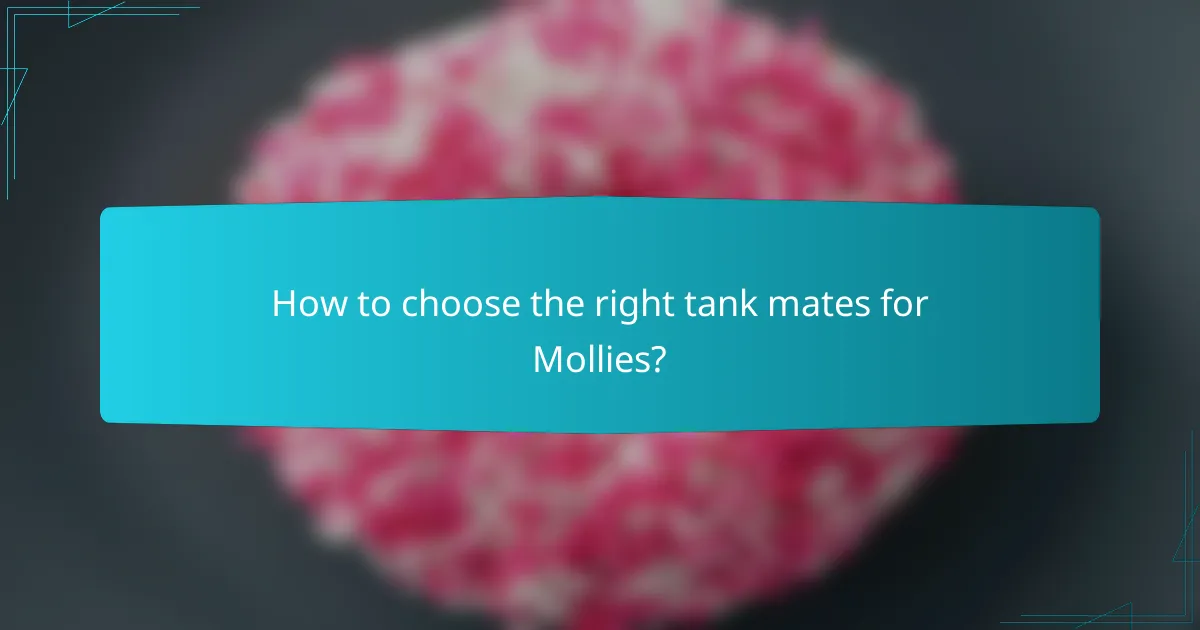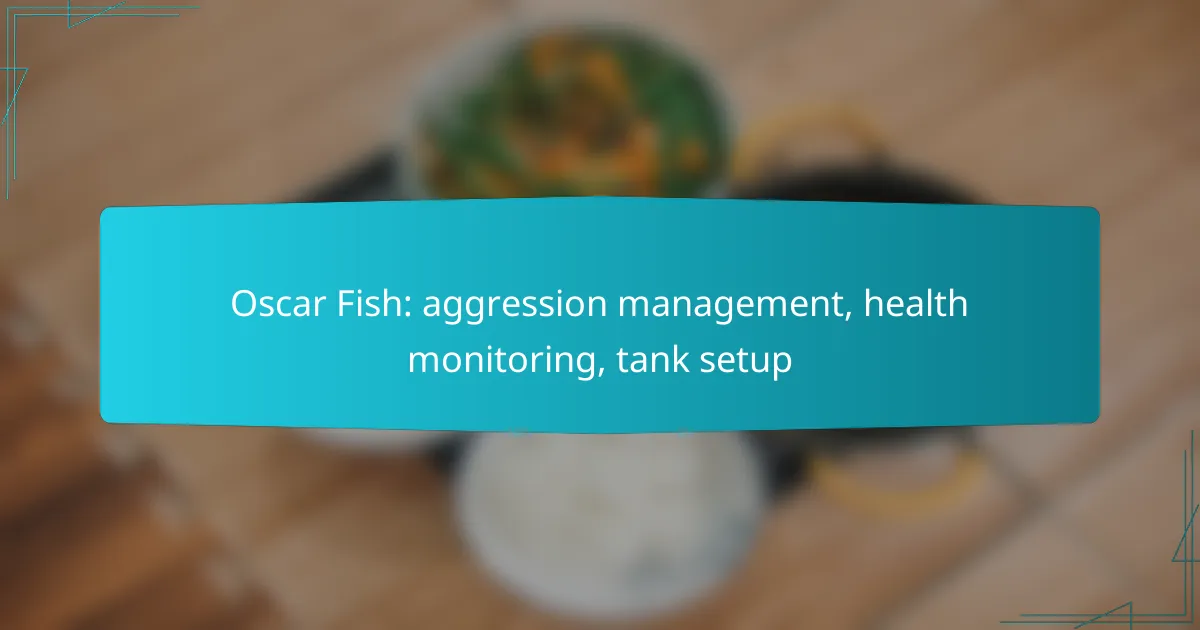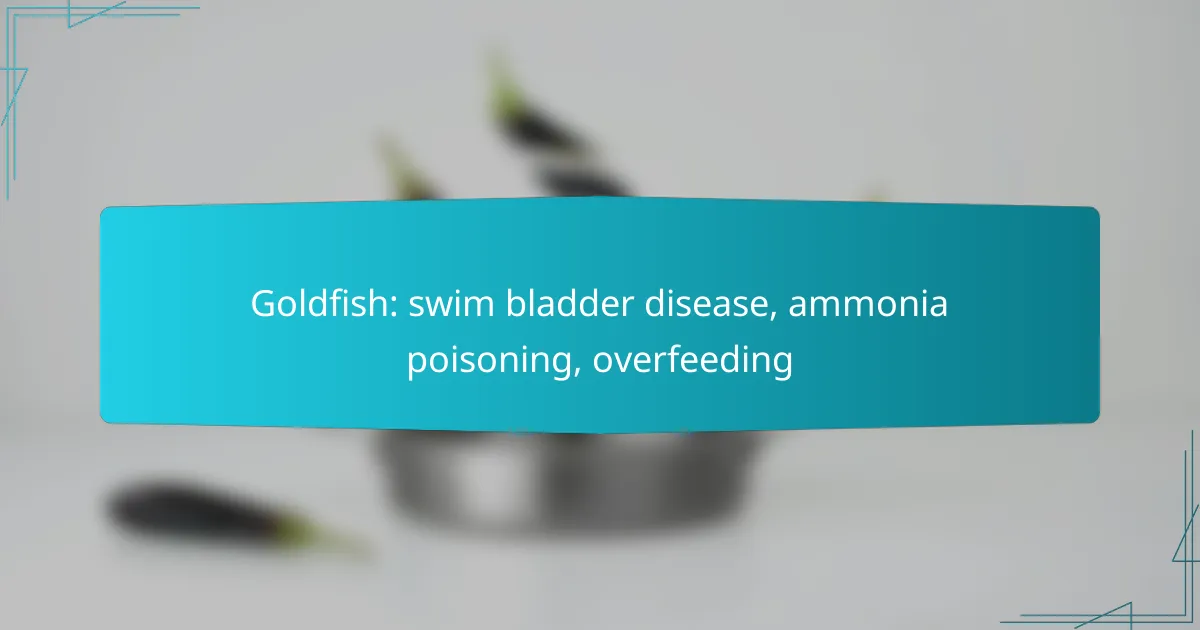Mollies thrive in optimal water conditions, making it essential to maintain the right temperature, pH, and hardness levels to promote their health. Preventing diseases involves not only ensuring these ideal conditions but also providing proper nutrition and management practices. Additionally, effective stress management techniques, such as creating hiding spots and avoiding overcrowding, can significantly enhance the well-being of your Mollies.

How to prevent diseases in Mollies?
Preventing diseases in Mollies involves maintaining optimal water conditions, proper nutrition, and good management practices. By focusing on these areas, you can significantly reduce the risk of illness in your fish.
Regular water testing
Regular water testing is crucial for preventing diseases in Mollies. Monitoring parameters such as pH, ammonia, nitrite, and nitrate levels helps ensure a healthy environment. Aim for a pH between 7.0 and 8.5 and keep ammonia and nitrite levels at zero.
Use reliable test kits to check water quality weekly, especially during changes in temperature or after adding new fish. Keeping a log of your water tests can help identify trends and potential issues early.
Vaccination options
Currently, there are limited vaccination options specifically for Mollies. However, some general fish vaccines can help protect against common diseases. Consult with a veterinarian who specializes in aquatic animals to explore available options.
While vaccinations may not be widely available for all fish, maintaining good water quality and a stress-free environment can enhance their natural immunity, reducing the likelihood of disease outbreaks.
Quarantine new fish
Quarantining new fish is essential to prevent the introduction of diseases into your existing tank. Keep new Mollies in a separate tank for at least two weeks to monitor for signs of illness. This practice helps ensure that any potential pathogens do not spread to your established fish.
During the quarantine period, observe the new fish closely for symptoms such as lethargy, abnormal swimming, or visible lesions. If any issues arise, consult a veterinarian for appropriate treatment before introducing them to the main tank.
Maintain optimal water temperature
Maintaining optimal water temperature is vital for the health of Mollies. These fish thrive in temperatures between 24°C and 28°C (75°F to 82°F). Sudden fluctuations can stress them and make them more susceptible to diseases.
Use a reliable aquarium heater and thermometer to keep the temperature stable. Regularly check the temperature, especially during seasonal changes, to ensure it remains within the ideal range.
Use high-quality food
Feeding Mollies high-quality food is essential for their overall health and disease prevention. A balanced diet rich in vitamins and minerals supports their immune system. Look for high-quality flakes or pellets specifically formulated for tropical fish.
Avoid overfeeding, as this can lead to poor water quality and health issues. Feed small amounts 1-2 times a day, ensuring that all food is consumed within a few minutes to maintain a clean environment.

What are the best stress management techniques for Mollies?
Effective stress management techniques for Mollies include providing hiding spots, maintaining stable water parameters, avoiding overcrowding, and using gentle filtration. Implementing these strategies can significantly enhance the well-being of your Mollies and reduce stress-related issues.
Provide hiding spots
Creating hiding spots in the aquarium is essential for reducing stress in Mollies. These fish naturally seek shelter to feel secure, especially when they are frightened or during breeding. You can use plants, rocks, or commercial decorations to create these safe spaces.
Consider using a variety of hiding spots at different levels in the tank to cater to all sizes of Mollies. This not only helps them feel safe but also encourages natural behaviors, which can lead to healthier fish.
Maintain stable water parameters
Stable water parameters are crucial for the health of Mollies and can significantly reduce stress. Aim for a temperature range of 24-28°C (75-82°F) and maintain a pH level between 7.5 and 8.5. Regular testing of water quality helps ensure these conditions remain stable.
Frequent water changes, ideally 10-20% weekly, can help maintain optimal conditions. Additionally, monitor ammonia, nitrite, and nitrate levels to prevent toxic build-up, which can lead to stress and illness.
Avoid overcrowding
Overcrowding can lead to increased stress levels in Mollies, as they require space to swim and establish territories. A general rule is to provide at least 1 gallon of water per inch of fish. For example, a 10-gallon tank can comfortably house around 5-6 Mollies.
Keep an eye on the fish’s behavior; if they seem aggressive or overly skittish, it may be a sign that the tank is too crowded. Adjust the number of fish accordingly to ensure a peaceful environment.
Use gentle filtration
Using gentle filtration is important for maintaining a calm environment for Mollies. Strong currents can stress these fish, making them feel vulnerable. Opt for a filter that provides adequate filtration without creating excessive water movement.
Consider using sponge filters or adjustable flow filters that allow you to control the water current. This ensures that the water remains clean while providing a comfortable habitat for your Mollies.

What water conditions are ideal for Mollies?
Ideal water conditions for Mollies include specific temperature, pH, and hardness levels that promote their health and well-being. Maintaining these parameters helps prevent diseases and reduces stress in these fish.
Temperature range: 75-82°F
Mollies thrive in a temperature range of 75-82°F (24-28°C). Keeping the water within this range is crucial for their metabolic processes and overall health. Sudden temperature fluctuations can lead to stress and susceptibility to diseases.
To maintain the ideal temperature, consider using a reliable aquarium heater and a thermometer. Regularly check the water temperature to ensure it remains stable, as Mollies are sensitive to extreme changes.
pH level: 7.5-8.5
The optimal pH level for Mollies is between 7.5 and 8.5, which reflects their natural habitat in slightly alkaline waters. Maintaining this pH range supports their immune system and reduces the risk of stress-related issues.
Test the water regularly using a pH test kit and adjust as necessary with pH buffers or natural methods like adding crushed coral. Avoid rapid changes in pH, as they can be harmful to the fish.
Hardness: 10-20 dGH
Mollies prefer water hardness levels between 10 and 20 dGH (degrees of general hardness). This range provides essential minerals that contribute to their health and reproductive success. Soft water can lead to health problems, while overly hard water may cause stress.
To measure water hardness, use a water hardness test kit. If adjustments are needed, consider adding mineral supplements or using specific substrates that can help achieve the desired hardness level. Regular monitoring is key to maintaining stable conditions.

What are the signs of stress in Mollies?
Signs of stress in Mollies include changes in behavior and physical appearance that indicate discomfort or poor health. Recognizing these signs early can help prevent further issues and improve their well-being.
Faded coloration
Faded coloration is a common indicator of stress in Mollies. When these fish are under stress, their vibrant colors may dull, making them appear less lively. This change can be caused by poor water quality, inadequate diet, or aggressive tank mates.
To address faded coloration, ensure that the water parameters are optimal, including temperature, pH, and ammonia levels. Regular water changes and a balanced diet can help restore their natural hues.
Erratic swimming behavior
Erratic swimming behavior is another sign of stress in Mollies. This can manifest as darting around the tank, swimming in circles, or frequently changing depths. Such behavior often indicates that the fish are feeling threatened or uncomfortable in their environment.
To mitigate erratic swimming, check for potential stressors such as overcrowding, aggressive tank mates, or sudden changes in water conditions. Providing hiding spots and ensuring a stable environment can help reduce anxiety.
Hiding excessively
Hiding excessively is a behavior that can signal stress in Mollies. While it’s normal for fish to seek shelter, if Mollies are constantly hiding and avoiding interaction, it may indicate they are feeling unsafe or stressed.
To encourage more active behavior, assess the tank setup for appropriate hiding spots and remove any aggressive fish. Maintaining a calm environment with suitable tank mates can help Mollies feel more secure and reduce their need to hide.

How to choose the right tank mates for Mollies?
Selecting the right tank mates for Mollies is crucial for their health and well-being. Ideal companions are peaceful fish that thrive in similar water conditions and share compatible temperaments.
Consider the size of the tank
The size of your aquarium plays a significant role in determining suitable tank mates for Mollies. A larger tank can accommodate a greater variety of fish, reducing territorial disputes. Aim for at least 20 gallons for a small group of Mollies and their companions to ensure ample space.
Choose compatible species
When selecting tank mates, prioritize species known for their peaceful nature. Good options include Guppies, Platies, and Corydoras catfish. Avoid aggressive fish like Cichlids or those that may nip fins, as they can stress Mollies and lead to health issues.
Match water parameters
Mollies prefer slightly brackish water with a pH between 7.5 and 8.5 and a temperature range of 24-28°C. Ensure that potential tank mates can thrive in similar conditions to prevent stress and health problems. Regularly test water quality to maintain a stable environment.
Monitor behavior
After introducing new tank mates, closely observe their interactions. Look for signs of aggression or stress, such as hiding or fin damage. If conflicts arise, be prepared to separate the fish to maintain a peaceful community tank.










